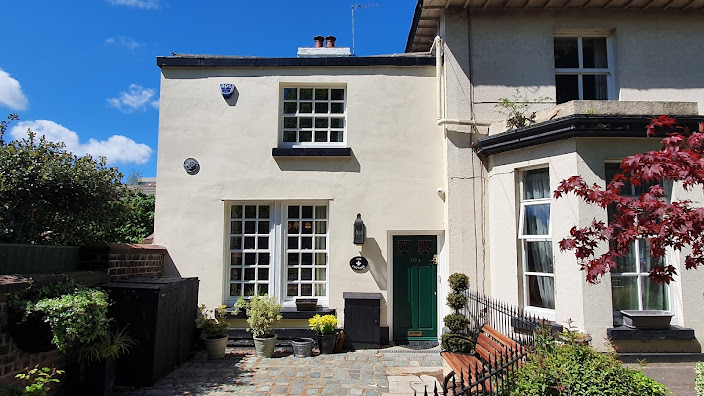Now known as the Penny Lane Emporium

So where exactly where these Tram Sheds that John was still thinking about in 1965? That's what fellow historian and Beatles blogger Steve Bradley wanted to know when he messaged me last week.

Paul McCartney: ‘Penny Lane’ was kind of nostalgic, but it was really a place that John and I knew; it was actually a bus terminus. I’d get a bus to his house and I’d have to change at Penny Lane, or the same with him to me, so we often hung out at that terminus, like a roundabout. [3]
Trams to Woolton via Smithdown Road and 'Penny Lane' ran until 15 October 1949 when the service was replaced by buses, which is clearly how Paul McCartney remembers it. Between 1940 and 1945 John Lennon lived for a time on Newcastle Road, just around the corner and it's no stretch to imagine that he actually saw the trams still in operation passing through the depot and heading along the bottom of his road, up Church Road towards Picton Clock.
I used quotation marks because the bus (and former tram) terminus (the "shelter in the middle of the roundabout") is not actually on Penny Lane. It sits on a triangular junction between Church Road, Allerton Road and Smithdown Road and faces one end of Penny Lane. Depending on where you were travelling to in the city it was often necessary to change at Penny Lane and buses with 'Penny Lane' displayed were common throughout Liverpool.
John Lennon: Penny
Lane is a suburban district where I lived with my mother and father (although
my father was a sailor, always at sea), and my grandfather. I lived on a street
called Newcastle Road [5].
So, the name Penny Lane was also applied to the area surrounding the bus terminus though some locals appear to dispute this. If you visit the area today, you might notice how many of the shops in that area have the words Penny Lane in their name (e.g., Penny Lane Flowers or the Penny Lane Emporium). Of course, these days it's hard to tell whether the owners are aware of the area name or are simply capitalizing on the Beatles' connection.
Trams passed through Penny Lane for the last time on 6 September 1952, but some routes continued in Liverpool for the next few years. On 14 September 1957 Liverpool's trams ran for the very last time, a parade of trams running from Bowring Park where I grew up (much later) towards the city centre.

In 1946, around the time that John Lennon settled in Woolton, his Uncle George was working the night shift at the depot on Woolton High Street, cleaning the trams. While John still lived at Newcastle Road it's said he enjoyed walks with his grandfather, 'Pop' Stanley and eldest cousin Stan, to places like Wavertree Park (the 'Mystery'), Sefton Park, and even as far as the Pier Head. They would have passed the entrance to the tram depot on Church Road (later known as the Prince Alfred Road bus depot) and probably paused to watch the goings on, as they walked towards Smithdown Place.
Given these early childhood memories it's likely that the young John had more than a passing interest in the trams and carried this through to his teenage years. On his way through Penny Lane on the No. 5 bus into town, heading for the Art College or perhaps a Beatles' engagement, he obviously noticed that many features of the Liverpool tram system remained well beyond the final closure.

A week later, with lockdown finally over in England I happened to be at the retail park behind the site waiting to pick up my son and thought I'd try and get a better photo.
To my surprise I found all the trees and vegetation had been cleared. Work could only have started in the last few weeks because workmen and an excavator were still on site.

I know I haven't been out much in the last twelve months, but I was quite excited by the unearthed archaeology. It must have been hidden for at least a quarter of a century. If anyone knows what this trench was used for, please get in touch.
Photos taken around the Smithdown Place roadworks in 2016, showing the shelter in the middle of the roundabout and St Barnabas Church (where Paul McCartney was a choir boy). Photos by Mr John Lunt and the Liverpool Echo.
























